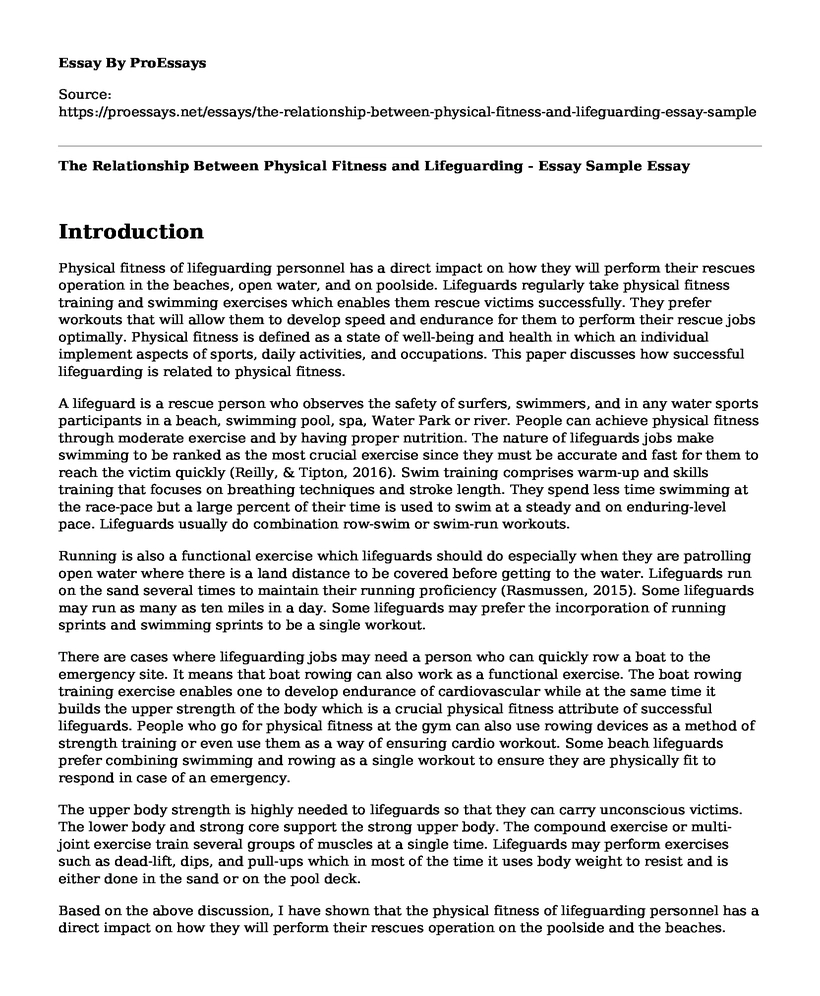Introduction
Physical fitness of lifeguarding personnel has a direct impact on how they will perform their rescues operation in the beaches, open water, and on poolside. Lifeguards regularly take physical fitness training and swimming exercises which enables them rescue victims successfully. They prefer workouts that will allow them to develop speed and endurance for them to perform their rescue jobs optimally. Physical fitness is defined as a state of well-being and health in which an individual implement aspects of sports, daily activities, and occupations. This paper discusses how successful lifeguarding is related to physical fitness.
A lifeguard is a rescue person who observes the safety of surfers, swimmers, and in any water sports participants in a beach, swimming pool, spa, Water Park or river. People can achieve physical fitness through moderate exercise and by having proper nutrition. The nature of lifeguards jobs make swimming to be ranked as the most crucial exercise since they must be accurate and fast for them to reach the victim quickly (Reilly, & Tipton, 2016). Swim training comprises warm-up and skills training that focuses on breathing techniques and stroke length. They spend less time swimming at the race-pace but a large percent of their time is used to swim at a steady and on enduring-level pace. Lifeguards usually do combination row-swim or swim-run workouts.
Running is also a functional exercise which lifeguards should do especially when they are patrolling open water where there is a land distance to be covered before getting to the water. Lifeguards run on the sand several times to maintain their running proficiency (Rasmussen, 2015). Some lifeguards may run as many as ten miles in a day. Some lifeguards may prefer the incorporation of running sprints and swimming sprints to be a single workout.
There are cases where lifeguarding jobs may need a person who can quickly row a boat to the emergency site. It means that boat rowing can also work as a functional exercise. The boat rowing training exercise enables one to develop endurance of cardiovascular while at the same time it builds the upper strength of the body which is a crucial physical fitness attribute of successful lifeguards. People who go for physical fitness at the gym can also use rowing devices as a method of strength training or even use them as a way of ensuring cardio workout. Some beach lifeguards prefer combining swimming and rowing as a single workout to ensure they are physically fit to respond in case of an emergency.
The upper body strength is highly needed to lifeguards so that they can carry unconscious victims. The lower body and strong core support the strong upper body. The compound exercise or multi-joint exercise train several groups of muscles at a single time. Lifeguards may perform exercises such as dead-lift, dips, and pull-ups which in most of the time it uses body weight to resist and is either done in the sand or on the pool deck.
Based on the above discussion, I have shown that the physical fitness of lifeguarding personnel has a direct impact on how they will perform their rescues operation on the poolside and the beaches. Lifeguards achieve physical fitness through moderate exercise and by having proper nutrition. The most crucial practice that lifeguards must take to ensure physical fitness are swimming, running, rowing and compound exercises.
References
Reilly, T., & Tipton, M. (2016). Occupational fitness and strength standards for beach lifeguarding. In The Science of Beach Lifeguarding (pp. 221-232). CRC Press, Boca Raton, FL.
Rasmussen, J. (2015). Lifeguard fitness readiness: Certification vs. qualification. Graduate Research Papers. 85. https://scholarworks.uni.edu/grp/85
Cite this page
The Relationship Between Physical Fitness and Lifeguarding - Essay Sample. (2022, Nov 30). Retrieved from https://proessays.net/essays/the-relationship-between-physical-fitness-and-lifeguarding-essay-sample
If you are the original author of this essay and no longer wish to have it published on the ProEssays website, please click below to request its removal:
- How Anxiety Affects the Outcome of Penalty Kicks
- Essay Sample on Athlete Career
- Essay Sample on Perfecting Performance of Student Athletes in Field of Sport
- Essay Sample on Fitness Assessment Program
- Essay Sample on Nutritional Requirements of Athletes
- College Sports: Understanding the Dedication and Coordination of Athletes - Essay Sample
- Paper Example on NFL TV Deal: Profits vs Fans, Prestige







